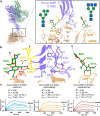Molecular basis of host recognition of human coronavirus 229E
- PMID: 40016196
- PMCID: PMC11868633
- DOI: 10.1038/s41467-025-57359-8
Molecular basis of host recognition of human coronavirus 229E
Abstract
Human coronavirus 229E (HCoV-229E) is the earliest CoV found to infect humans. It binds to the human aminopeptidase N (hAPN) through the receptor binding domain (RBD) of its spike (S) protein to achieve host recognition. We present the cryo-electron microscopy structure of two HCoV-229E S protein in complex with a dimeric hAPN to provide structural insights on how the HCoV-229E S protein opens up its RBD to engage with its host receptor, information that is currently missing among alphacoronaviruses to which HCoV-229E belong. We quantitatively profile the glycosylation of HCoV-229E S protein and hAPN to deduce the glyco-shielding effects pertinent to antigenicity and host recognition. Finally, we present an atomic model of fully glycosylated HCoV-229E S in complex with hAPN anchored on their respective membrane bilayers to recapitulate the structural basis of the first step of host infection by HCoV-229E.
© 2025. The Author(s).
Conflict of interest statement
Competing interests: The authors declare no competing interest.
Figures






References
MeSH terms
Substances
Grants and funding
LinkOut - more resources
Full Text Sources

